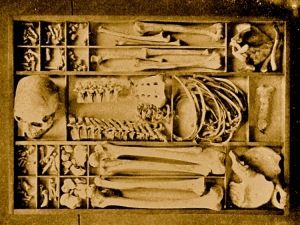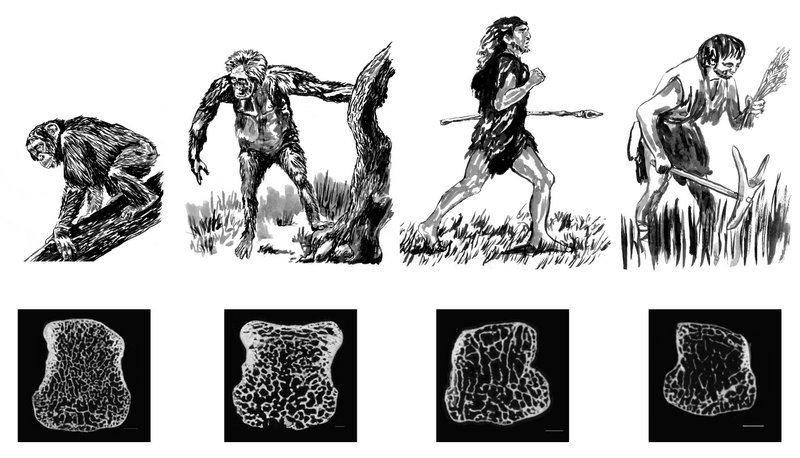
Based on research published this week in the journal, Proceedings of the National Academy of Sciences, scientists are suggesting that humans evolved with a weaker bone structure after they left their hunter-gatherer lifestyle thousands of years ago, with modern health implications for today’s populations.
According to one lead study author, Habiba Chirchir: “Our study shows that modern humans have less bone density than seen in related species, and it doesn’t matter if we look at bones from people who lived in an industrial society or agriculturalist populations that had a more active life. They both have much less bone density” compared to humans who led a hunter-gatherer lifestyle thousands of years ago. Chirchir is a postdoctoral researcher at the Smithsonian Institution’s National Museum of Natural History.
The research sought to determine the bone density difference among both human and non-human primate species across thousands of years of evolutionary history using comparative high-resolution imaging of ancient and more recent human bone samples, from human farmers and hunter-gatherers who lived in a region contained by the present-day State of Illinois in the U.S. to hominid species thought to be ancestral to humans deep in human evolutionary prehistory in other parts of the world, as well as chimpanzees. The researchers focused on trabecular structure, specifically the ‘spongy’ portion of the bone that characterizes joints such as in the hips, knees, ankles, and arm joints.
The researchers found that the trabecular structure is similar in all populations, except that among bones associated with hunter-gatherer populations, the mesh, or spongy portion, has a much higher amount of actual bone relative to air. “Trabecular bone has much greater plasticity than other bone, changing shape and direction depending on the loads imposed on it; it can change structure from being pin or rod-like to much thicker, almost plate-like. In the hunter-gatherer bones, everything was thickened,” said a study co-author, Dr Colin Shaw from the University of Cambridge’s Phenotypic Adaptability, Variation and Evolution (PAVE) Research Group.
The thickening, say the researchers, results from constant loading on the bone, which creates minor damage in the bone mesh, causing it to grow back stronger and thicker throughout life. The building reaches a ‘peak point’ of bone strength, which can also counter-balance deterioration of bones with age.
Most significantly, the results showed low trabecular density only among recent modern humans, and that the decrease is especially pronounced in the lower joints, such as in the hip, knee, and ankle, and less so among the upper joints—the shoulder, elbow, and hand. The researchers suggest that the emergence of this change late in human evolutionary history may have been due to transition from a nomadic, hunter-gatherer lifestyle to a more settled lifestyle.
“Much to our surprise, throughout our deep past, we see that our human ancestors and relatives, who lived in natural settings, had very dense bone. And even early members of our species, going back 20,000 years or so, had bone that was about as dense as seen in other modern species,” said Brian Richmond, a study author, curator with the American Museum of Natural History and research professor at George Washington University. “But this density drastically drops off in more recent times, when we started to use agricultural tools to grow food and settle in one place.”
__________________________________
This image show a comparison between bone mass in a hunter-gatherer and an agriculturalist hip joint. Courtesy Timothy Ryan and Colin Shaw
____________________________________
This illustration shows that modern people (right) have unusually low density in bones throughout the skeleton, including the hand bone joints (metacarpal heads) shown here. This new study found that bone joint density remained high throughout human evolution spanning millions of years, until it decreased significantly in recent modern humans, probably as a result of an increasingly sedentary lifestyle. From left to right: modern chimpanzee, Australopithecus, Neanderthal, and modern human. Credit: © AMNH/J. Steffey
__________________________________________________
Some researchers believe that an important tip could be drawn from the research for today’s human populations. “You can absolutely morph even your bones so that they deal with stress and strain more effectively,” says Shaw. “Hip fractures, for example, don’t have to happen simply because you get older if you build your bone strength up earlier in life, so that as you age it never drops below that level where fractures can easily occur.”
“The fact is,” continues Shaw, “we can be as strong as an orangutan – we’re just not, because we are not challenging our bones with enough loading, predisposing us to have weaker bones so that, as we age, situations arise where bones are breaking when, previously, they would not have.”
The research thus also provides an anthropological basis for explaining modern bone conditions like osteoporosis, a bone-weakening condition that develops with age among modern populations because of decreased walking due to sedentary lifestyles and modern transportation conveniences.
“Over the vast majority of human prehistory, our ancestors engaged in far more activity over longer distances than we do today,” said Richmond. “We cannot fully understand human health today without knowing how our bodies evolved to work in the past, so it is important to understand how our skeletons evolved within the context of those high levels of activity.”
The research is published in the Proceedings of the National Academy of Sciences (PNAS).
_______________________________________
Source Information: The American Museum of Natural History and the University of Cambridge
_________________________________________________
Just released!
The special new premium quality print edition of Popular Archaeology Magazine. A beautiful volume for the coffee table.
Travel and learn with Far Horizons.
____________________________________________
Read about the most fascinating discoveries with a premium subscription to Popular Archaeology Magazine. Find out what Popular Archaeology Magazine is all about. AND MORE:
On the go? Get the smartphone version of Popular Archaeology as an app or as an ebook.
Popular Archaeology’s annual Discovery Edition eBook is a selection of the best stories published in Popular Archaeology Magazine in past issues, with an emphasis on some of the most significant, groundbreaking, or fascinating discoveries in the fields of archaeology and paleoanthropology and related fields. At least some of the articles have been updated or revised specifically for the Discovery edition. We can confidently say that there is no other single issue of an archaeology-related magazine, paper print or online, that contains as much major feature article content as this one. The latest issue, volume 2, has just been released. Go to the Discovery edition page for more information.









